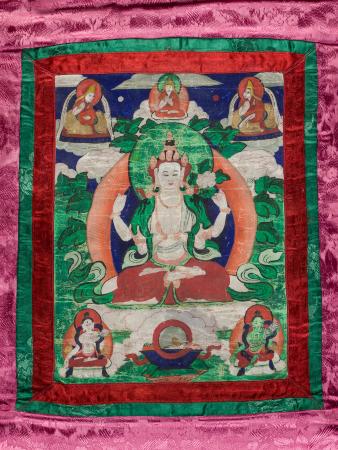Buddha with arhats
- Inventory number:
- Ж-1329
- Author:
- Unknown
- Creation Date:
- 19th century
- Place of Creation:
- Buryatia
- Provenance:
- Received from a private individual
- Technique:
- painting
- Size:
- 31.5 x 24 cm
- Material:
- canvas, mineral paint
- Type of object:
- Thangka
- Subject:
- Buddhism
Buddha Shakyamuni (563 BC – 483 BC) was an Indian spiritual teacher, ascetic, and the founder of Buddhism. Accounts of his life, teachings, and the monastic rules he developed were summarized after his death and memorized by the community of his followers, known as the sangha. Initially passed down orally, these teachings were written down around four hundred years after the Buddha’s death, forming the sacred Buddhist texts called the “Tripitaka”. Images of Buddha Shakyamuni are an essential element of a Buddhist altar.
Buddha Shakyamuni is depicted surrounded by sixteen senior disciples (sthavira), who vowed not to enter nirvana until the time specified by the Buddha. They swore to protect the Buddha’s teachings (Dharma) for the salvation of living beings from the bonds of existence – sansara. These disciples include: Abhedaya, Ajita, Angaja, Bhadra, Vajriputra, Bakula, Vanavasin, Kalika, Gopaka, Kanaka Bharadhvaja, Kanakavasta, Nagasena, Panthaka, Pindola Bharadhvaja, Rahula, Chudapanthaka, also known as arhats. The sthavira are accompanied by the monk Heshang and the layperson Dharmatala, who, according to legend, invited the arhats, Buddha’s disciples, to visit China. At the top center is the image of Vajradhara, the primordial Buddha. Below are the four Maharajas, or great kings, guardians of the four directions (from left to right): Virudhaka, Dhṛtarāṣṭra, Virupaksha, and Vaishravana.
